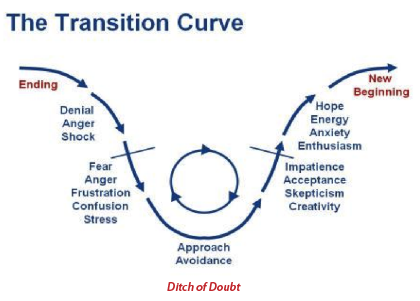 Editor's note: Amanda Farnsworth is Head of Visual Journalism at BBC News and a featured speaker at SAS Global Forum 2017, April 2-5, 2017 in Orlando.
Editor's note: Amanda Farnsworth is Head of Visual Journalism at BBC News and a featured speaker at SAS Global Forum 2017, April 2-5, 2017 in Orlando.
There was a best selling book some years ago called “Men are from Mars and Women are from Venus.” It’s a phrase I thought about a lot when I first started my current job, not so much in the gender sense, but because it can be really challenging to bring together teams with very different experiences, skillsets and, above all, cultures.
Different strokes
In 2013, I was asked to form a new department – Visual Journalism – bringing together Online Designers, TV Designers and Online Journalists with an aptitude for graphics and visuals as well as Developers who worked with me but not for me. These included people staffing the many Language Services of the BBC World Service. The different teams produced content for the BBC News website, TV 24hr News Channels and Bulletins.
And boy, were they all different!
The digital folk were very creative but in a controlled way. They worked with a set visual design language and liked to do this as a structured process which involved a lot of user testing focusing on what the audience would understand and how would they behave when faced with some of our visual content.
Meanwhile, those with a TV background liked to work in a much more fluid way – creative workshops and experimentation - with less audience focus, as it was so much harder to get proper audience feedback on the visual elements of a TV report that viewers would get a single chance to see and take in.
And, as everyone who has gone through change knows, it can be a scary and difficult time for many of those involved. I have always found The Transition Curve one of the most useful things I ever learnt in a management course, helping me to identify how different parts of the team might be handling change. I stuck this diagram on a filing cabinet next to my desk when I created the Visual Journalism team.
And there was one other thing: I had a predominantly TV background and I was now being asked to lead a team that was packed full of digital experts. I’d always prided myself on my technical as well as editorial ability, and now I was less technically skilled than most of the people working for me. How was I going to cope with that?
New beginnings
The first thing I did was to offer 30-minute one-on-ones with my staff. About 60% agreed. I sent them a questionnaire to fill in in advance and asked them these three questions:
1. What Single Thing could we do very quickly that would change things for the better?
2. How can the new Visual Journalism team work better together?
3. What new tools do you need to do your job?
It proved to be a treasure trove of information with some interesting thoughts and great suggestions – here are a few examples of Q1 answers:
“A single management structure for the whole team. Sometimes different disciplines within the team clash as they are pulled in different directions by the priorities of their respective managers. This wastes time and creates unnecessary tensions.”
“Unfortunately we have a rather corrosive habit of 'rumour control' which is usually of a negative nature, particularly in this time of change and uncertainty. I think 'rumour control' can easily be reduced by providing as much information as possible ( good and bad ) so none is left to be made up!”
“I would like to see a re-evaluation of the planning area. A map that just happens to be going on air tomorrow, Should that be taking up a slot in planning? Maybe planning should be more focussed on projects that are moving us and our journalism forward. “
And from question 2:
“One word: flexibility. The teams need to absorb the concept that we have one goal, the individual outputs need to grasp this to. A respect for the established disciplines is all well and good, but tribalism needs to be left behind.”
So I had a lot of face time with a lot of staff. They all appreciated the dedicated time, but it also gave me a chance to meet them individually. The questionnaires gave me a written record of all their top concerns which I could refer to in the coming months and use as a justification or guide for change. And I could say after six months that I had done a lot of the things they had asked for along with other things that I felt needed to be done.
In addition, I wanted the teams to meet each other. So, we held a Speed Dating session. We made two long rows of chairs facing each other and sat TV people on one side and online people on the other. They had one minute to say what they did and one minute to listen to the person opposite them share the same before I sounded a horn and everyone moved down one chair. It was a bit chaotic and a little hysterical to watch, but proved to be a great way of breaking the ice between the teams.
After a month in which I also immersed myself in the work of the various teams with a series of show and tells and shadowing days, and asked external stakeholders what they wanted from the new department, I drew up my vision.
It’s main message was that we were now a cross-platform team who needed to share ideas, information, skills and assets to create great, innovative content across TV and Digital.
The build phase
Even as we began the process of real change, the outside world suddenly started to move quickly. More and more of our news website traffic started to come from mobile, not desktop devices, and the distinction between what was TV and what was Digital began to blur, with the use of more video and motion graphics online. Social media platforms proliferated and became a key way of reaching an audience that didn’t usually access BBCTV or Digital content. We found ourselves on the cutting edge of where TV meets the web. And we had to make the most of it.
I began a series of internal attachments where online and TV designers learnt each other’s skills. I supplemented that with training so they could learn new software tools and design techniques. The lines between journalists and designers also began to fade, with many editorial people learning motion graphics skills for use on the increasingly important social media platforms.
I also encouraged and stood the cost of people spending a month outside the department learning how other parts of the BBC News machine worked and help spread the word that the new dynamic Visual Journalism department wanted to partner up and do big high impact, cross platform projects.
I revamped our Twitter feed, offered myself and other colleagues for public speaking at conferences and made sure we entered our best work for awards.
Quite quickly this all began to pay dividends. We won a big data journalism prize and we formed some big external partnerships with universities doing interesting research and with official bodies like the Office for National Statistics. We received a big investment for more data journalism from our Global division and from BBC Sport who wanted to do some big data led projects around the World Cup and Olympics.
Social glue was also important. We instituted a now legendary annual pot-luck Christmas lunch where the tables groaned with the amazing food people brought in to share. The Christmas jumpers are always impressive and we hold a raffle and quiz too.
There was, and still is, a major job to do just listening and looking after the staff. I make a point of praising and rewarding great work. We don’t have a great deal of flexibility on pay at the BBC, but rewards like attending international conferences, getting training opportunities and receiving some retail vouchers from the scheme the BBC runs all help. I also always facilitate flexible working as much as is humanly possible, not just for women returning to work after maternity leave, but for caregivers, people who want to work part-time and most recently for two new dads who are going to take advantage of the paternal leave scheme and be the sole parent at home for six months while their wives return to work.
I also write an end-of-year review and look ahead to the next 12 months that I send to all staff. It outlines achievements and great content we have made but also the aims, objectives and challenges for the year ahead.
Not all plain sailing
Of course there were and still are some issues. As the Transition Curve shows, not everyone is going to follow you and embrace the change you bring. Team members who have been expert in their fields and are happy doing what they do suddenly find they have to learn new things and can feel de-skilled. By definition, they cannot be an immediate expert at something new that they are asked to do and that can be difficult.
As roles and responsibilities blurred, we found we had to redefine the production process for online content as people became unsure of their roles.
Meanwhile such was the external reputation of the team, we suffered a brain drain to Apple, Amazon and Adidas.
And for me, as the department grew to over 160 people when I took on responsibility for the Picture Editors who edit the video for news and current affairs reports, I had to accept I was going to be more of an enabler and provider of editorial oversight than a practitioner. Technology was moving so fast, while I had to know and understand it, actually being able to create content myself was going to be a rare occurrence.
Conclusion
Writing this post has helped me see just how far we’ve come as a department in a few short years. It’s certainly not perfect and the challenges we face are ever–changing. But we have now won over 25 awards across all platforms and the cross-platform vision is embedded in the teams who really enjoy learning from each other and working on projects together.
And, I have a secret weapon. I enjoy singing pop songs at my desk everyday and of course Carols at Christmas.
Trying not to encourage me to sing is something literally everyone can unite behind.

